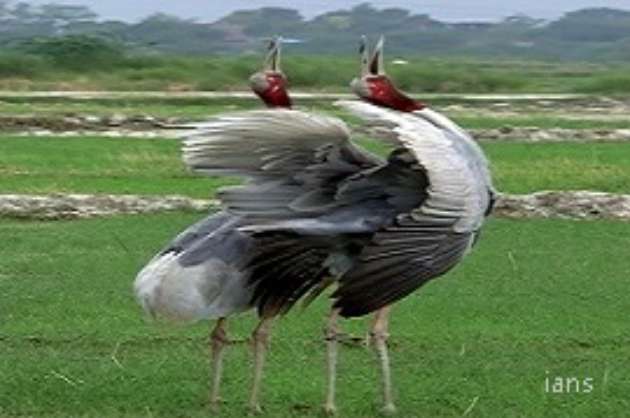New Delhi, April 10
Cranes are famous for living in pairs, with partnerships forming for life.
In India, Sarus cranes have a reputation for taking it a step further — if one of a pair dies the second crane is said to die pining in grief for the partner, say researchers at the Nature Conservation Foundation who watched stork nests for over two decades.
Breeding crane pairs raise their chicks in territories that they fiercely defend from other cranes.
This defence is commonly in the form of a loud unison call, or duet, where both cranes call together that, to an untrained ear, sounds like one bird is calling. This duet call warns other cranes not to come too close.
Real estate, it seems, is very serious in the crane world, and being a pair for long periods allows the cranes to synchronize their calls and produce perfect duets, they say.
A long-term study conducted across Nepal and India now shows the Sarus crane pairs altering their behaviour. When conditions deteriorated, the pairs allowed a third crane into their territory to help raise chicks.
These trios, the study found, behave as a cogent social unit and like pairs, give a unison call with all three cranes calling in synchrony.
This behaviour of cranes is completely new, and researchers had to think of a new name for the unison calls of trios. They have named these calls triets.
Explaining the behaviour, K.S. Gopi Sundar, the lead scientist of the study and the global Co-chair of the IUCN Stork, Ibis and Spoonbill Specialist Group, said they have discovered many unknown facts about this species, among them being their behaviour of being aggressively territorial.
He has been monitoring over 1,000 Sarus crane pairs since 1998 when he began his studies of the bird in Uttar Pradesh.
In places like Uttar Pradesh where irrigation canals and the monsoon help provide water throughout the year, the breeding Sarus cranes maintain territories throughout the year.
In other areas like Rajasthan and some parts of Gujarat, where water dries up during the severely hot summers, territorial pairs are forced to join other cranes in the few existing water bodies on the landscape.
In the recent study, Sundar, also a scientist with the Nature Conservation Foundation, along with his colleague Swati Kittur and student Suhridam Roy, showed how cranes, once thought to be inflexible in their behaviour of defending territories as pairs, appear to be getting help raising their chicks.
Their scientific paper recording trios as a distinct and novel social unit of cranes was published in the journal "Ecology", a publication of the Ecological Society of America.
The team found trios everywhere they looked, across Nepal and India. The trios they found were both polygynous — one male with two females — and polyandrous — one female and two males.
This was greatly unusual since in other bird species trios tend to largely be polyandrous with males being related to each other, Sundar said.
One trio that Sundar has been monitoring since 1999 in Uttar Pradesh provided some fascinating insights into how the crane pairs appear to be trading off their strong instinct to defend territories.
The third crane vanished from the territory when the breeding season started and appeared again only when the chicks were over a month old.
This trio, despite being in a territory that had very little wetlands and was therefore of very poor quality, had a very high breeding success.
The third crane was clearly helping find food for the chicks and benefiting the territorial pair by improving their ability to raise chicks successfully each year.
Roy, who is studying the structure and functions of Sarus crane calls with Sundar, was able to record the triets even managing to film one unison call of trios.
Trios unison called in the exact same pattern as normal pairs, with triets having the same kind of synchrony between the calls of the three cranes like duets do.
Triets were of a lower frequency compared to duets, but the reason for this difference could not be determined in this study.
Lower frequency calls travel much further, and Sundar is guessing that trios may want to communicate their ownership of land to a longer distance.
During the study, the scientists found that areas with many Sarus crane pairs, which is possible only when the area is high quality, had fewer trios.
As the number of pairs declined on the landscape, or as habitat quality declined, the trios increased.
Swati Kittur, who managed the long-term data set and mapped out the distribution of the trios for the study, suggests that this pattern connecting trios and habitat quality may mean that Sarus cranes changed their behaviour over time as conditions to raise chicks declined.
Her database has over 11,500 records of Sarus crane groups, and trios were quite rare being only 1.6 per cent of all observations.
Such major changes in behaviour are being noticed in other bird species too, such as albatrosses, who were thought to be entirely monogamous, not mating with birds outside of the pair.
Scientists who documented the albatross behavioural change showed that climate change was likely responsible for this major alteration of behaviour.
Many aspects of Sarus crane trios remain to be studied, but the researchers of this new study suspect that trios are not restricted to Sarus cranes alone but are very likely existing in other crane species too.
Studies of crane social units are very few. It may also be that researchers assume that crane behaviour is inflexible and are not looking carefully.
Sundar and his team suspect that trios will be reported in many other crane species especially since habitat deterioration, especially declines of wetlands, is going on around the world.
Watching species like cranes remains greatly popular for tourism and photography across the world, but Sundar bemoans the absence of careful observations and studies for most of the crane species, and especially the species like Sarus cranes that are found in tropical and sub-tropical areas.
Local scientists who live alongside the cranes have great opportunities to conduct long-term and careful observations with relatively little investment.
Together, he says, these scientists can raise the alarm if conditions decline too much causing major changes in behaviour.
Given the alarming and rapid changes that are ongoing as part of global climate change, the scientists owe the cranes a careful look.
The good news is that the study adds to the mythology of Sarus cranes. So far, Indian farmers considered cranes to be faithful to each other.
The new study shows that they are also super committed parents willing to take on behaviours that deviate entirely from long-standing habits for the benefit of their chicks.
This combination of faithfulness and great parenting means that Sarus cranes will continue to weather at least some of the changing conditions humans are creating for them.
Sundar believes that retaining traditional farming and helping farmers raise suitable crops is the key to conservation of species like Sarus cranes that largely live on farmlands.
"The cranes have begun signalling that conditions are changing for them. We have realised that they are changing their behaviour. We now need to change ours for the betterment of farmlands and wetlands, that they need so urgently," added Sundar.




























